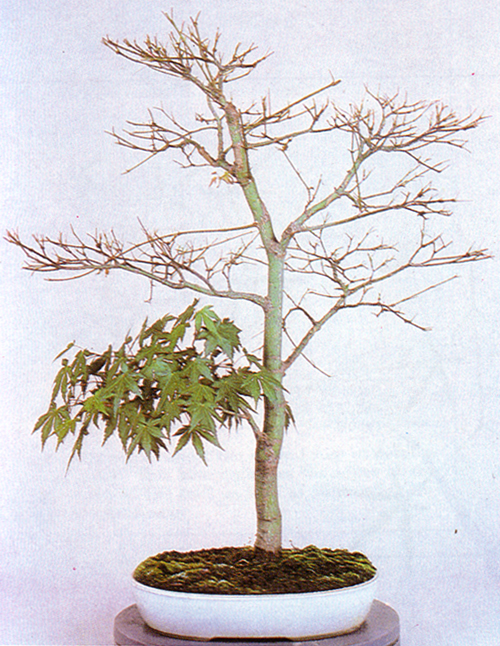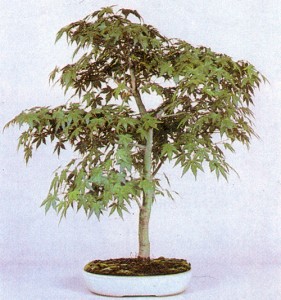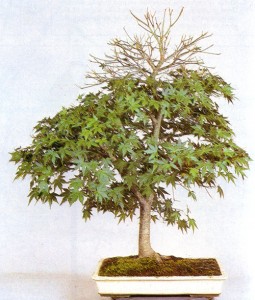
This Japanese maple (Acer palmatum) has been partially defoliated. The first branch is too small relative to the rest of the tree, so the purpose of the defoliation is to speed up the development of the first branch while slowing down the development of the rest of the tree. This works because energy flow decreases in areas that have been defoliated. Conversely, because the energy from the roots has to go somewhere, energy flow increases where leaves are left on. The photos in this post are from Bonsai Today issue 103 (out of print). The article that the photos are taken from is by Hiroshi Takeyama.

Before defoliation. Too much energy is flowing to the upper reaches of the tree. Without redirecting this energy, the top will continue to strengthen, while the lower branch remains relatively weak. This occurs because most trees (including maples), are apically dominant, i.e. most of the energy flows up towards the tree’s apex. Because of this disproportionate energy flow, it would be impossible to style most bonsai without some sort of energy balancing.
Defoliation Defined
Defoliation is simply cutting off foliage (leaves). Though the word defoliation is used outside of bonsai to describe conditions caused by chemicals or disease, it is distinctive to bonsai as an styling technique.
Three primary reasons to defoliate
For styling purposes, defoliation is commonly used for three purposes: reducing leaf size, increasing fine branching (ramification) and redirecting energy. This post is primarily concerned with the third purpose; redirecting energy.
Defoliating for health
Defoliation can also be used to remove diseased or insect infested leaves. Or leaves that have been damaged by sun, wind or other factors.
When wiring
It’s not unusual to remove some leaves when you wire just to get them out of the way.
When pruning
Sometimes it helps to remove some leaves on a branch before pruning so you can better see exactly where to cut.
Timing
If you plan on doing extensive defoliation, be sure to give the tree plenty of time to recover and develop strong new leaves before cold weather starts to set in. Here in Vermont this means we need to defoliate in the early summer. In warmer climes you can defoliate well into mid-summer.
How to defoliate; coming soon
Stay posted, we’ll cover the how-to next time. Meanwhile, if you insist on going ahead, by sure to use sharp shears and to cut the petioles (leaf stems) at the half way point.

Only the apex has been defoliated on this maple. Because maples and most trees are apically dominant, it is sometimes necessary to redirect energy downward. You could accomplish this by simply pruning off the top of the tree, but in this case, the artist wants to keep the top as it is (at least for now) while encouraging growth in the rest of the tree.
Our last post on energy balancing was on sacrifice branching. You will find links there for earlier posts on energy balancing.
Stay posted for much more on defoliation and other energy balancing topics.
Thanks for the tips. I’ve used defoliation to reduce leaf size, remove damaged or diseased leaves, improve ramification, but never did it for energy balancing. I’m looking forward to trying this technique on my deciduous trees.
Although I know this was posted a long time ago, I have only recently become acquainted with your blog. I like it very much. In the above examples, I understand what you say, but I don’t understand why it works this way. It seems to me that the natural growth of the tree (apical) would force the tree to ‘repair’ the damage done to the top, and push more energy there to replace the loss leaves. Why doesn’t this repair increase growth like the increased growth around a scar? Thanks for your time. Carolee
Carolee,
I’m not sure why plants stop growth for a while where there are fresh cuts, but my best guess goes like this: When branches, twigs or leaves are first cut, energy starts flowing elsewhere very quickly to prevent excess bleeding. Later energy is restored to the cut area.